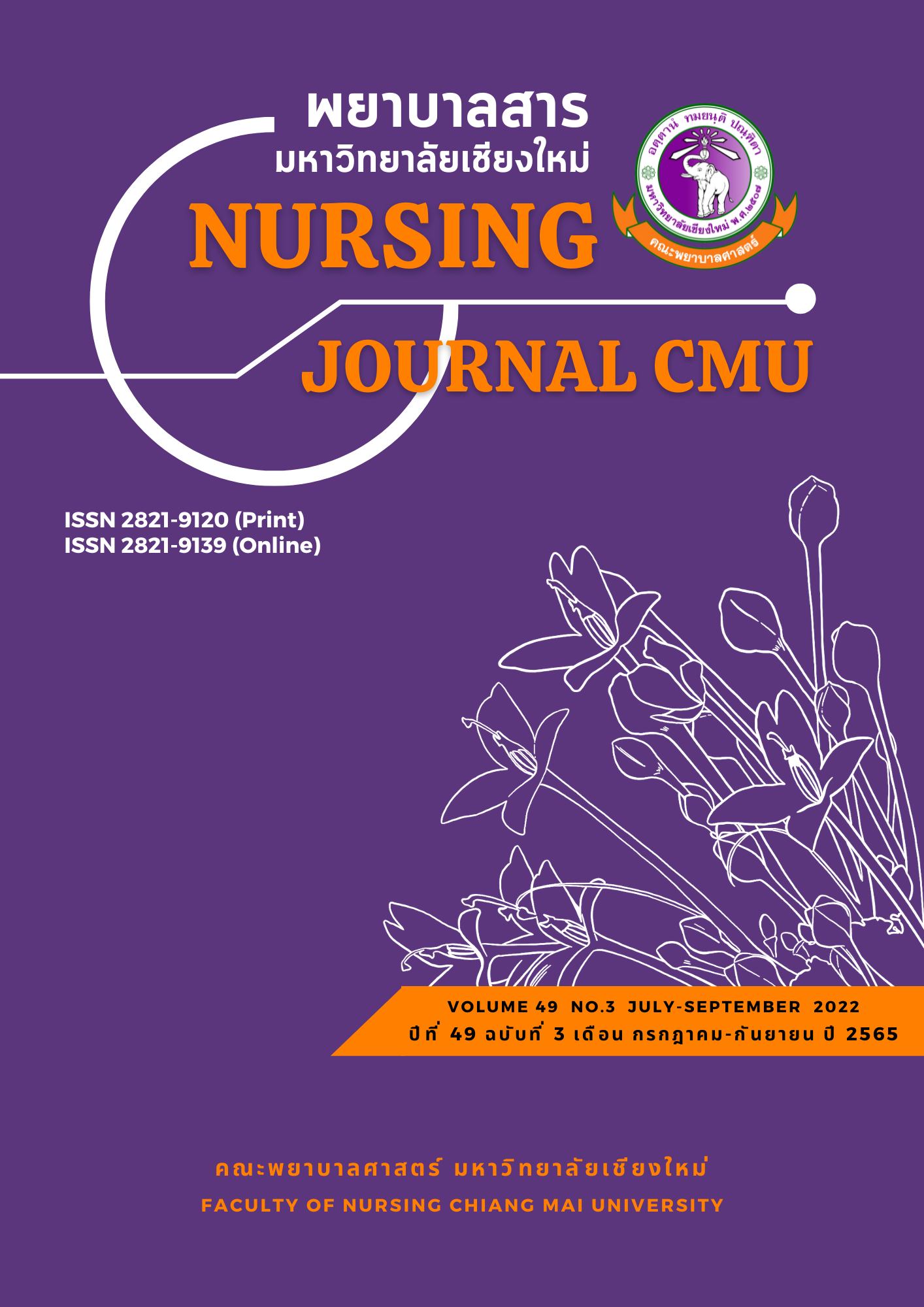ปัจจัยที่เกี่ยวข้องกับการดูแลแบบเอื้ออาทรของพยาบาลเด็กในโรงพยาบาลระดับตติยภูมิ
คำสำคัญ:
การดูแลแบบเอื้ออาทร, เด็กป่วยและผู้ดูแล , พยาบาลวิชาชีพบทคัดย่อ
การดูแลแบบเอื้ออาทรของพยาบาลเด็ก เกิดจากการประสานความร่วมมือระหว่างพยาบาลกับเด็กป่วยและครอบครัว ทำให้เด็กป่วยได้รับการดูแลแบบองค์รวม การวิจัยเชิงพรรณนาแบบหาความสัมพันธ์ครั้งนี้มีวัตถุประสงค์เพื่อศึกษาการดูแลแบบเอื้ออาทรของพยาบาลเด็ก ความสัมพันธ์ระหว่างความมั่นคงทางอารมณ์และบรรยากาศองค์กรกับการดูแลแบบเอื้ออาทรตามการรับรู้ของพยาบาลเด็ก โดยใช้กรอบแนวคิดการดูแลแบบเอื้ออาทรของวัตสัน (Watson, 1988) ร่วมกับการทบทวนวรรณกรรมที่เกี่ยวข้อง คัดเลือกกลุ่มตัวอย่างแบบเฉพาะเจาะจง คือ พยาบาลวิชาชีพ ที่ปฏิบัติงานในหอผู้ป่วยสามัญกุมารเวชกรรม ในโรงพยาบาลระดับตติยภูมิในเขตภาคเหนือตอนบน จำนวน 98 ราย เครื่องมือที่ใช้รวบรวมข้อมูล ประกอบด้วย แบบสอบถามความมั่นคงทางอารมณ์ แบบสอบถามบรรยากาศองค์กร และแบบสอบถามพฤติกรรมการดูแลแบบเอื้ออาทรของพยาบาลเด็ก วิเคราะห์ข้อมูลโดยใช้สถิติพรรณนา และสถิติ Spearman’s rank correlation coefficient.
ผลการวิจัยพบว่า
- คะแนนเฉลี่ยการดูแลแบบเอื้ออาทรของพยาบาลเด็ก โดยรวมอยู่ในระดับสูง (= 102.36, SD = 12.09) เมื่อพิจารณารายด้าน พบว่าคะแนนเฉลี่ยรายด้าน 9 ด้านจาก 10 ด้านอยู่ในระดับสูง ด้านที่มีค่าเฉลี่ยมากที่สุดคือด้านที่ 8 ประคับประคองสนับสนุนและแก้ไขสิ่งแวดล้อมด้านกายภาพจิตสังคมและจิตวิญญาณ (= 17.41, SD = 2.37 ในขณะที่ด้านที่ 10 ยอมรับสิ่งที่เกิดขึ้น พลังที่มีอยู่ อยู่ในระดับปานกลาง (= 1.91, SD = 0.70)
- ความมั่นคงทางอารมณ์ของพยาบาลมีความสัมพันธ์ทางบวกระดับสูงกับการดูแลแบบเอื้ออาทรของพยาบาลเด็ก อย่างมีนัยสำคัญทางสถิติ (rs =.694, p < .05) และบรรยากาศองค์กรมีความสัมพันธ์ทางบวกระดับสูงกับการดูแลแบบเอื้ออาทรของพยาบาลเด็ก อย่างมีนัยสำคัญทางสถิติ (rs =.673, p < .05)
ผลการวิจัยในครั้งนี้ทำให้ได้ข้อมูลพื้นฐานปัจจัยที่เกี่ยวข้องกับการดูแลแบบเอื้ออาทรของพยาบาล ดังนั้นการส่งเสริมให้พยาบาลเด็กมีความมั่นคงทางอารมณ์สูง และสร้างบรรยากาศองค์กร เพื่อให้มีการดูแลแบบเอื้ออาทรมากขึ้น และตอบสนองความต้องการของเด็กป่วยและครอบครัวอย่างเป็นองค์รวม
เอกสารอ้างอิง
Anatun, A., Ting, T., Chieh, Y. L., Shu, F. V., & Mary, E. M. (2018). Caring behavior perceived by nurses, patients and nursing students in Indonesia. Journal of Professional Nursing,34(2), 314-319.
Bitsani, E. (2013). Theoretical approaches to the organizational culture and the organizationalclimate: Exploratory research examples and best policies in health care services.Journal of Human Resource Management, 1(4), 48-58.
Brunton, B., & Beaman. (2000). Nurse practitioners’ perceptions of their caring behavior. Journal of the American Academy of Nurse practitioners, 12, 451-456.
Burns, N., & Grove, S. K. (2009). The practice of nursing research: Appraisal, synthesis, and Generation of evidence (6th ed.). St. Louis, MO: Saunders Elsevier.
Coyne. (2006). Children’s experiences of hospital. Journal of child Health Care, 10(4), 326-336.
Danphathong, A. (2009). Caring behaviors of end of life patients as per the perception ofnurses. Journal of Nursing Division, 36(1), 15-26. (in Thai)
Hockenberry, M. J., & Wilson, D. (2009). Wong’s essentials of pediatric nursing (8thed.). St. Louis, MO: Mosby/Elsevier.
Hughes, L. (2009). Peer group caring interaction scale and organizational climate forquestionnaire. In J. Watson (Ed.). Assessing and measuring caring in nursing and health sciences (2nd ed., pp. 149-162). New York: Springer.
Kaewvichien, S., & Sangkhamal. S. (2016), The development of nursing system for pediatric patients undergoing an open heart surgery at Queen Sirikit National Institute of Child Health. Research Thai Journal of Cardio-Thoracic Nursing, 27(1), 56-71. (in Thai)
Klunklin, P. (2017). Pediatric nursing for health promotion. Chiang Mai: Smart Coating. (in Thai)
Kongbunyapong, B., & Pinchaleaw, D. (2016). Factors Influencing Happiness in work place of professional nurses, community hospital, Surat Thani Province. Journal of The Police Nurse, 8(2), 151-160. (in Thai)
Litwin, G. H., & Stringer, R. A. (1968). Motivation and organization climate. Boston: Graduate School of Business Administration.
Lueluang, W., & Vorahan, W. (2011). Factors influencing role practices of professional nurses at operating room in regional hospitals, northeast region. (Master’s thesis of Nursing Science in Adult Nursing). Chiang Mai University. (in Thai)
Manojlovich, M. (2005). Professional nursing practice in hospital settings. Nursing Research, 54, 41-47.
Medical Records Unit. (2017). Statistical report. Chiang Mai: Medical Statistics Unit Maharaj Nakorn Chiang Mai Hospital.
Ormel, J., Bastiaansen, A., Riese, H., Bos, E. H., Servaas, M., Ellenbogen, M., & Aleman, A.(2013). The biological and psychological basis of neuroticism: Current status and futuredirections. Research Neuroscience and Biobehavioral, 37(1), 59-72.
Polit, D. F. (2010). Statistics and data analysis for nursing. research (2nd ed.). New Jersey:Pearson.
Raksamanee, A. (2007). Relationship between job characteristics. ethical intelligence with the ability of operating room nurses State University Hospital. Chulalongkorn University: Bangkok. Retrieved from https://doi.nrct.go.th/ListDoi/listDetail?Resolve_
Rerksadayut, P. (2013). Caring behaviors of perioperative nurses and related factors as perceived by perioperative. (Master’s thesis of Nursing Science in Adult Nursing). Prince of Songkla University. (in Thai)
Roach, M. S. (2002). Caring: The human mode of being (2nd ed.). Ottawa: CHA Press.
Ronald, J. B., Matthiesen, S. B., & Pallesen, S. (2005). Personality and individual differences.
Research Personality and Individual Differences 40, 1223–1233. Skulpunyawat, S. (2014). Supervision by the caring behavior. Journal of The Police Nurse, 6(2), 200-208.
Srisathitnarakun, B. (2007). The methodology in nursing research. Bangkok: U & I International Media. (in Thai)
Teng, C. I., Chang, S. S., & Hsu, K. H. (2009). Emotional stability of nurses: Impact on patient safety. Journal of Advanced Nursing, 65, 2088-2096.
Watson, J. (1988). Nursing the philosophy and science of caring. Colorado: Colorado Associated University press.
Wolf, Z. R., Giardino, E. R., & Osborne, M. S. (1994). Dimension of nurse caring. Image–the Journal of Nursing Scholarship, 26(2), 107-111.
Wongcheeree, T. (2011). Factors influencing parent participation in the care of hospitalized children. The Journal of Faculty of Nursing Burapha University, 19(3), 23-36. (in Thai)
ดาวน์โหลด
เผยแพร่แล้ว
รูปแบบการอ้างอิง
ฉบับ
ประเภทบทความ
สัญญาอนุญาต
ลิขสิทธิ์ (c) 2022 พยาบาลสาร

อนุญาตภายใต้เงื่อนไข Creative Commons Attribution-NonCommercial-NoDerivatives 4.0 International License.
บทความที่ได้รับการตีพิมพ์เป็นลิขสิทธิ์ของวารสารพยาบาลสาร
ข้อความที่ปรากฏในบทความแต่ละเรื่องในวารสารวิชาการเล่มนี้เป็นความคิดเห็นส่วนตัวของผู้เขียนแต่ละท่านไม่เกี่ยวข้องกับมหาวิทยาลัยเชียงใหม่ และคณาจารย์ท่านอื่นๆในมหาวิทยาลัยฯ แต่อย่างใด ความรับผิดชอบองค์ประกอบทั้งหมดของบทความแต่ละเรื่องเป็นของผู้เขียนแต่ละท่าน หากมีความผิดพลาดใด ๆ ผู้เขียนแต่ละท่านจะรับผิดชอบบทความของตนเองแต่ผู้เดียว






